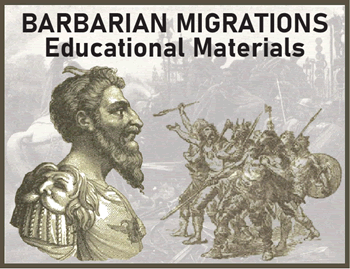The Barbarian Migrations, also known as the Migration Period or Völkerwanderung in German, were a series of large-scale population movements and migrations of various ethnic groups in Europe during the late antiquity and early medieval periods, roughly spanning from the 4th to the 9th centuries C.E. These migrations had far-reaching consequences for the political, cultural, and demographic landscape of Europe. Our 100% free educational materials are designed to increase student retention and comprehension of the Barbarian Migrations.
 Causes:
Causes:
- Pressure from the Huns: The migrations were triggered, in part, by the westward expansion of the Huns, a nomadic people from Central Asia. Their aggressive campaigns pushed various Germanic tribes and other peoples westward and into Roman territories.
- Economic and Environmental Factors: Factors such as climate change, famine, overpopulation, and competition for resources contributed to the migrations. These factors often pushed groups to seek more fertile or hospitable lands.
- Political Instability: The decline of the Roman Empire and internal political instability created power vacuums that some migrating groups sought to exploit.
Key Migrating Groups:
- Germanic Tribes: Germanic peoples, including the Visigoths, Ostrogoths, Vandals, and Franks, played a significant role in the migrations. The Visigoths, for instance, sacked Rome in 410 C.E.
- Huns: The Huns themselves were a migrating group that caused a domino effect as they pushed other groups westward.
- Attila the Hun: The Hunnic leader Attila, known as the "Scourge of God," led invasions into the Eastern Roman Empire and Western Europe, causing further migrations.
- Huns and Germanic Tribes: The Huns and Germanic tribes formed alliances and fought together at times.
Consequences:
- End of the Western Roman Empire: The migrations contributed to the fall of the Western Roman Empire. In 476 C.E., the Germanic chieftain Odoacer deposed the last Roman emperor, Romulus Augustulus, marking the end of the Western Roman Empire.
- Rise of New Kingdoms: As migrating groups settled in various regions, they established their own kingdoms and polities. The Visigoths established the Visigothic Kingdom in the Iberian Peninsula, the Vandals established the Vandal Kingdom in North Africa, and the Franks laid the foundation for what would become the Carolingian Empire.
- Cultural Exchange: The migrations facilitated cultural exchange and interaction between different ethnic groups, leading to the blending of cultures, languages, and traditions.
- Christianization: The spread of Christianity was influenced by the migrations. Many migrating groups, such as the Visigoths and Franks, converted to Christianity, which had a lasting impact on the religious landscape of Europe.
Legacy:
- Medieval Europe: The migrations marked the transition from late antiquity to the medieval period in Europe. The new kingdoms and polities that emerged played a role in shaping the medieval landscape.
- Formation of Modern Nations: Some of the migrating groups played a foundational role in the formation of modern European nations. For example, the Franks laid the groundwork for the future nation of France.
- Continuing Ethnic Identities: The migrations also contributed to the preservation of various ethnic identities and cultures, many of which are still recognized today.
The Barbarian Migrations were a complex and transformative period in European history, marked by the movement of peoples, the decline of one of the world's greatest empires, and the emergence of new political and cultural entities. These migrations helped shape the medieval and, ultimately, the modern European world.
Our free educational materials are designed to facilitate student learning on this pivotal period in European history. |

 Causes:
Causes:








